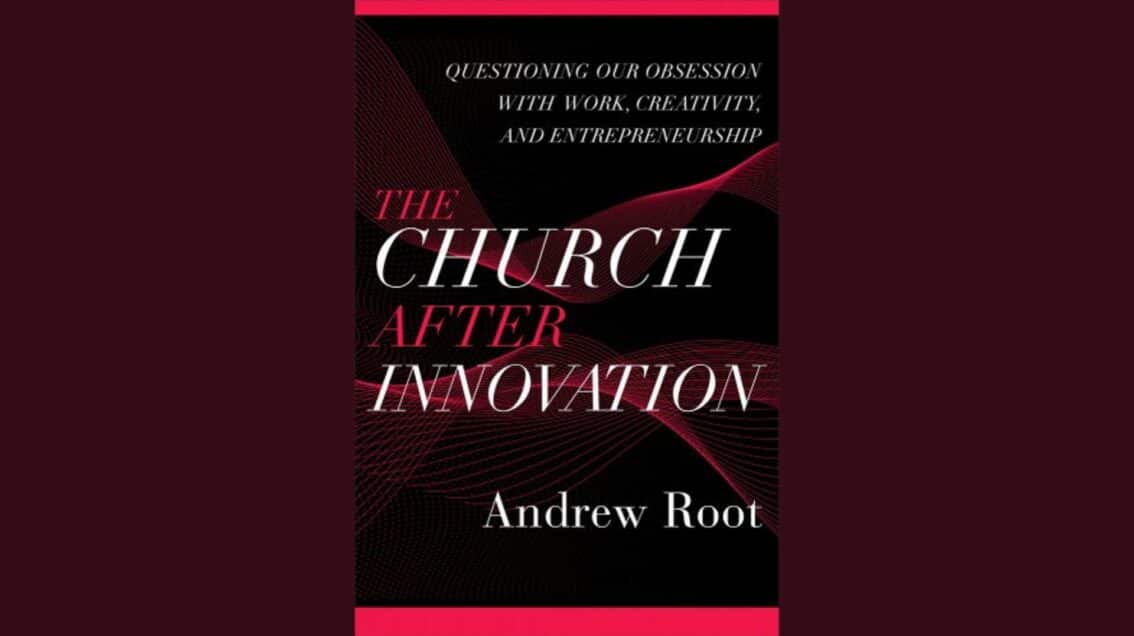

THE CHURCH AFTER INNOVATION: Questioning Our Obsession with Work, Creativity, and Entrepreneurship. By Andrew Root. Grand Rapids, MI: Baker Academic, 2022. Xvi + 242 pages.
We live in an age of innovation where creativity and entrepreneurship are valued everywhere. Why? Because the fact that change is everywhere requires it, or so we’ve been led to think. Thus, if you are going to succeed in this environment then you must embrace perpetual innovation. I like my smartphone, vaccines for a virus that has spread across the globe, and all the other blessings of this innovative age. So, I’m not opposed to innovation, but have we put ourselves on a treadmill that seems impossible to keep up with? Besides, does our embrace of innovation at times exceed what is truly necessary? Consider the fact that my computer becomes obsolete as soon as I purchase it, which means that while it still works fine, it needs to be replaced annually (or so it seems). That spirit of innovation, which is, according to Andrew Root, rooted in neo-liberal capitalism, has found its way into the church. Yes, for the church to survive and thrive in this new age of innovation, it needs to be innovative and entrepreneurial. So, we either get on board or get left behind.

Robert D. Cornwall
Andrew Root has been writing about the challenges facing the church as it navigates this increasingly secular age, producing a series of books that have caught the attention of many clergy including myself. The Church After Innovation quickly followed Churches and the Crisis of Decline: A Hopeful, Practical Ecclesiology for a Secular Age, which came out earlier in 2022. These books followed earlier contributions to the series including The Congregation in a Secular Age: Keeping Sacred Time Against the Speed of Modern Life, along with several others that form his series of books that focus on Ministry in a Secular Age. I have found each of the books I’ve read, and I’ve not read them all, helpful as I’ve reflected on the realities facing the churches in the twenty-first century.
Of his books that focus on the challenges facing the churches in this secular age, in my opinion, this may be the most poignant. In an earlier book, Root pointed out that the secular age seems to be speeding up, with change happening at breakneck speed (the perennial search for innovation contributes to that feeling). While this is happening, the churches try to keep up. Unfortunately, we can’t keep up and we continue to fall further behind. But to keep up, we embrace the clarion call to innovate. While creativity is good, the danger, as Root helpfully lays out in this book, innovation can end up being an idol around which the church centers its identity (along with the rest of us). In fact, the idol might be the creative self that seeks uniqueness as a singularity. That is, we are constantly told that in this new age, we need to be our unique self and that anything less than being this unique self is to be basic, and who wants to be basic? This need to be unique leads us to become obsessively competitive, such that we want to exceed what others are doing. It is a never-ending process all in the name of being unique.
While Root regularly engages with Charles Taylor’s analysis of secularism in his books, he will also bring in scholars/figures who speak more specifically about the area of concern under discussion. In The Church after Innovation, Root draws on the works of Andreas Reckwitz, including his books The Invention of Creativity: Modern Society and the Culture of the New and The Society of Singularities. He places Reckwitz’s theories in conversation with what he calls the “new Protestant ecclesial obsession with innovation and entrepreneurship. We’ll see how this obsession is funded by both the late-modern drive toward singularity of self and the late-modern invention of creativity as a high (at times the highest) good” (p. xii). He notes that while he doesn’t ignore theology, his focus here is on the cultural-philosophical discussion. The question he wants us to consider is whether being innovative and creative is the best way to be faithful as Christians.
Root begins The Church after Innovation with a story about a Lutheran synod event where Root had been invited to speak. Before he spoke a younger member of the clergy, whom he calls “Applebees Boy,” made a presentation, in which the speaker argued that the church must be creative if it is to survive. That is, “It is time to innovate or die. THE CHURCH knows that it is now or never. Design a new way forward or disappear. Innovation is THE CHURCH’s only Hope!” Like Applebees, either we innovate or die. At that same meeting, he encounters “Synod Executive Guy” who is tasked with distributing money received from the sale of closed churches. He is faced with discerning whether to follow the lead of some in the church who would love to use that money to fix roofs and such in existing churches so that these churches can sustain ministry. The other option, the one he favors, is investing in innovation. He encounters a third person, a curmudgeonly older clergyman, a traditionalist of sorts, whom he calls “Bearded Brown Turtleneck.” This figure, whom he encounters at lunch at this meeting registers his unhappiness with all the talk about innovation that runs counter to his vision of the church rooted in tradition. There is a second storyline in the book that parallels the first. This story concerns Russ, a pastor working with young adults who are seeking funding for a project to enhance the congregation’s ministry with young adults. The challenge faced by Russ is that the group he pulls together gets stymied by the need to create something unique. Their problem is that in their mind even a good idea isn’t good enough because it’s not unique enough. In the end, the group falls apart, due in large part to this competitive spirit that prevents them from embracing a good project that isn’t deemed unique enough.
It’s important to note that Root is not opposed to change or innovation. He doesn’t share “Bearded Brown Turtleneck’s” commitment to tradition that leads to a rejection of all forms of change, innovation, and creativity. Nevertheless, he would like us to see that the pursuit of innovation many have embraced is rooted in neoliberal capitalism. That reality might come as a surprise to some progressive Christians who have embraced innovation and entrepreneurship but dislike capitalism. Again, Root isn’t opposed to innovation, but he wants us to be discerning lest we become obsessed with innovation and the problem of the inflation of the self that often accompanies this obsession.
Chapters 2 through 6 focus on the changing nature of capitalism, work, and identity in American culture. In these chapters, Root explores how post-World War II/Cold War Keynesian economics divided the public work world from the private world. Thus, in that age when the church was exploding, the church largely lived within the private sphere. To get a sense of the era, think of Leave it to Beaver. Ward’s work life was completely separate from Wally and Beaver’s home/school life. Things began to change in the 1970s as the divide between the two spheres began to disappear, such that the two spheres became intermingled. As Keynesian economics gave way to neoliberal capitalism in the late 1970s and 1980s, the economic focus turned from production to innovation and creativity. The former economic vision produced stability, but this new economic system has proved less stable. Nevertheless, in the new system, everyone is free to become whomever and whatever they wish. In this new world, the singular self becomes central. Thus, creativity/innovation rather than stability is the goal (think gig economy). This change of systems leads to changes in how management was conceived. In the former way of doing things, management focused on production (getting things done), whereas, in the new economy, management focuses on enabling people to fulfill their unique identities in the belief that this will unleash creativity/innovation. In other words, we innovate or die. Why is this important for the church? Well, what happens in the larger world tends to wash back into the life of the church. We innovate or we die! While innovation and creativity aren’t bad things, they can ultimately prove destructive when they become the end game.
When we get to chapter 6, which Root titles “The Viennese Worm That Exposes the True Self,” we begin to explore more deeply this concept of the unique self. Whereas in the Victorian world, it was the home that was most formative to one’s identity. However, when Freud came on the scene things began to change. No longer would the home serve as a haven, where identity was formed. Instead, the home was the place where one lost one’s true self. With Freud, the goal was breaking free from one’s home. Although the 1950s provided a return to the Victorian idea of the home serving as the haven where the self was formed, by the time we reached the 1960s this world began to fall apart. In this new world that fully blossomed with the neoliberal capitalism of the 1980s and 90s, places where one could pursue innovation became the locus for discovering one’s identity, that is, one’s true self.
In chapter 7, titled “Justification by Creative Works Alone,” Root takes a closer look at the role that the pursuit of creativity plays in the “self” becoming a star. Here Root talks about the fear many have developed of being basic, for no one wants to be basic. We all want to be unique, that is, a singularity. In this new world, standardization is set aside in favor of uniqueness. In this world, the “designer wears the crown.” This emphasis on creativity and uniqueness leads to an inflation of the self. We move further into this reality in chapter 8, where we might not be special, but we need to feel special. That is, we need to be a singular self. Following Andreas Reckwitz, Root shows how we seek to live in a society of singularities that fears being seen as basic/standardized/non-unique. Again, this feeds into the church, such that congregations and denominations feel the need to be freed from standardization. We feel the need to create our unique niche. The goal is to become liberated from old forms and functions, to become a “new creation” of sorts. Interestingly, churches that have moved most fully into expressive creativity tend to move away from the denomination. In doing their own thing they have little need for the denomination. The danger here is the competitive spirit and the focus on evaluation, where everything is appraised based on being a singularity. As he reminds us in chapter 9, it tends to be all about the money. Here he brings in the story of St. Francis of Assisi who stood naked against the money. Money is important, and a key to reform, but, money and the concept of debt can feed in on itself. That can prove destructive to the church’s life by giving into the illusion of power where all relationships are instrumentalized.
Having laid out the dangers of this constant pursuit of innovation, we might be wondering how we can get off this ever-ending wheel that leads to a constant search for the unique self that leads to a competitive spirit that requires constant evaluation. Before we continue, I need to reaffirm what I’ve said before — Andrew Root isn’t against creativity or innovation in the church. However, he does offer a warning about the dangers of getting caught up in it, such that we end up burning out. When we come to chapter ten, which he titles “The Three Amigos of the Mystical Path,” Root offers us three resources that can help us regain our equilibrium and thus freedom from the pursuit of an unattainable singularity. These resources are to be found in the mystical path that is laid out by Meister Eckhardt, John Tauler, and the author of Theologica Germanica. He opens chapter 10, by telling us what happened to the Synod Executive Guy and Applebees Boy when the pandemic hit. This might be a spoiler alert, but interestingly, the Synod Executive Guy ended up deflated as his attempts at innovation began to bend back on him, while Applebee’s Boy left the ministry entirely. While burnout can be the end result of the endless pursuit of singularity through innovation, Root suggests that the mystical path offered by Eckhardt, Tauler, and the Theologica Germanica can take us back to Jesus. What he wants us to hear in chapter ten is that the constant focus on the pursuit of being a singularity ends up pushing God out of the conversation. These teachers of the mystical path, however, can help us turn back to God by drawing us into God’s grace. To get there, however, we’ll need to be willing to let go of the need to be the star. That begins with our preconceptions about God. By letting go, we can let go of the spectral god of money. If we embrace this path, then growth is no longer the goal. Rather, God is the goal. Root brings The Church after Innovation to a close in chapter eleven. In this concluding chapter Root again takes us to Germany where we encounter Shelling, Hegel, and Friedrich Holderlin, whose efforts led to the birth of the Romantic tradition as a response to the Enlightenment. This opens up a conversation about a theology of the cross that addresses the question of authenticity, which is something our culture seems to embrace, but perhaps misunderstands.
I must reiterate that for Andrew Root, creativity is not the problem. Creativity is a good thing, except when we get so caught up in the search for the unique self that is defined by creativity/innovation that we end up losing ourselves. That is, change is not a bad thing, but if we burn out in pursuit of change while embracing the idea that everything depends on us, then we put ourselves in a position where we can’t receive the gifts of God. That is, we cut ourselves off from the beauty that comes from God.
Although I have retired from active pastoral leadership of a congregation, I am well aware of the challenges facing the church. I’m aware of the constant push for innovation, which promises to save us from decline. While I no longer face the responsibility of leading a congregation, I found Andrew Root’s The Church after Innovation to be a liberating word that can help us understand our context where innovation is the goal. Part of that liberation is to be found in the realization that what we’ve embraced is neoliberal capitalism without even recognizing it. Ultimately, the question for the church is whether the church will die without embracing permanent innovation! Interestingly, while Applebees seeks to innovate or die, I’ve noticed that a lot of their restaurants have been closing down. So, perhaps neo-liberal capitalism isn’t the church’s savior! Thankfully, in Andrew Root’s The Church after Innovation, we have an excellent resource to help us navigate this new world without getting swallowed by it.
This review originally appeared on BobCornwall.com.
Robert D. Cornwall is an ordained minister in the Christian Church (Disciples of Christ). Now retired from his ministry at Central Woodward Christian Church (Disciples of Christ) of Troy, Michigan, he serves as Minister-at-Large in Troy. He holds a Ph.D. in Historical Theology from Fuller Theological Seminary and is the author of numerous books including his latest books: Called to Bless: Finding Hope by Reclaiming Our Spiritual Roots (Cascade Books, 2021) and Unfettered Spirit: Spiritual Gifts for the New Great Awakening, 2nd Edition, (Energion Publications, 2021). His blog Ponderings on a Faith Journey can be found at www.bobcornwall.com.






